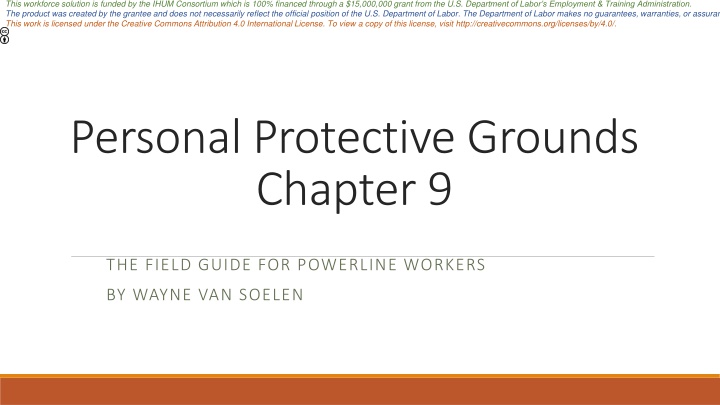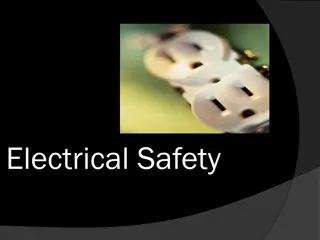Importance of Personal Protective Grounds in Electrical Work
Personal protective grounds play a crucial role in ensuring the safety of powerline workers. They provide isolation, protection from accidental re-energization, and safeguard against induction risks. Proper installation and sizing of grounding equipment are essential to control current flow and manage fault currents effectively in hazardous electrical environments.
Download Presentation

Please find below an Image/Link to download the presentation.
The content on the website is provided AS IS for your information and personal use only. It may not be sold, licensed, or shared on other websites without obtaining consent from the author.If you encounter any issues during the download, it is possible that the publisher has removed the file from their server.
You are allowed to download the files provided on this website for personal or commercial use, subject to the condition that they are used lawfully. All files are the property of their respective owners.
The content on the website is provided AS IS for your information and personal use only. It may not be sold, licensed, or shared on other websites without obtaining consent from the author.
E N D
Presentation Transcript
This workforce solution is funded by the IHUM Consortium which is 100% financed through a $15,000,000 grant from the U.S. Department of Labors Employment & Training Administration. The product was created by the grantee and does not necessarily reflect the official position of the U.S. Department of Labor. The Department of Labor makes no guarantees, warranties, or assurances of any kind, express or implied, with respect to such i This work is licensed under the Creative Commons Attribution 4.0 International License. To view a copy of this license, visit http://creativecommons.org/licenses/by/4.0/. Personal Protective Grounds Chapter 9 THE FIELD GUIDE FOR POWERLINE WORKERS BY WAYNE VAN SOELEN
9.1 Three Reasons to Install Personal Protective Grounds To provide isolation: After isolation and testing the installation of grounds is the final proof the correct circuit/line is being worked on To have protection from accidental re-energization: Re-energization can occur due to operator error, contact with other circuits, lightning or back feed To provide protection from induction: There are two types of induction: Electrostatic induction voltage is induced from an adjacent circuit Electromagnetic induction current is induced when a magnetic field and electric conductor move relative to one another
9.2.1 Control Current and Voltage The Grounding Principle personal protective grounds are installed to reduce any current flow through a worker to an acceptable level by providing a low-resistance parallel shunt around the worker. Also, if the circuit is or becomes energized, the grounds must be big enough to withstand any fault current in the circuit.
9.2.1 Controlling Current Flow The cable and clamps being used for personal protective grounds must be the correct type and size to be able to with stand the fault current available at the work site. Fault current is the electric current that flows through a circuit during an electric fault condition. A fault occurs when one or more electrical conductors contact a ground or each other (opposite phases) Types of faults are phase-to-ground, phase-to-phase and three phase A fault current can be several times larger in magnitude than the current that normally flows through a circuit Grounding Cable Size Fault Current Rating #2 10 kA 4/0 30 kA Continuous Current Rating 200 A 400 A
9.2.1 Fault Current Fault current is typically very high in substations
9.2.1 Controlling Current Flow During a fault grounds can whip around very violently Poor connections result in high resistance during a fault When a person on a structure is in contact with a circuit that is accidentally re-energized, the protective ground(s) and the person provide two parallel paths to ground. To provide a good shunt (ground) the protective grounds must be kept in excellent condition
9.2.2 Bonding to Control Voltage The Bonding Principle bonds must be installed so a worker is kept in an equipotential zone, meaning all equipment and the worker are and remain at the same potential A worker must NOT be able to bridge between a grounded circuit and any un-bonded structure, vehicle, boom, wire or other object not tied to the bonded network.
9.3.1 Equipotential Grounding Using the equipotential grounding method is to assure the pole and conductors on the pole are electrically connected to each other. Any person working on a structure that is not bonded to the grounds will be a parallel path to ground through the pole or structure. Keep the grounds as close as possible to the work site. The difference of potential between a phase and the neutral can become dangerous when working more than 300 feet from the installed set of grounds. Equipotential ground is also referred to as single point grounding
9.3.1 Grounding Electrode Regardless of the type of ground method being used, it is essential to use the most effective electrode (path to ground). On a Wye system, the system neutral is the best electrode. Some utilities may insist on an additional cable being installed that goes to a ground rod driven or screwed into the earth On a Delta system, the ground electrode will be the best electrode. The electrode that is used can vary from utility to utility. Typically a ground rod is driven or screwed into the earth. Using an anchor rod as the electrode is not recommended; anchor rods are typically galvanized and also maybe be rusty or corroded which can result in a high resistance connection.
9.3.2 Bracket Grounding Bracket grounding refers to working between grounds that have been installed on both sides of the work site. Bracket grounding DOES NOT adequately protect a worker from accidental re-energization; therefore, it must be seen as an exception to equipotential grounding. Bracket grounding will protect a worker from induction and back feed from small portable generators. How far the grounds can be located from the work site will vary by utility; the range seems to be from .5 mile to up to 2 miles apart. Remember, the farther the grounds are from the work site the greater the possibility of having a difference in potential between the phases and neutral. 9.3.3 Transmission Grounding the same methods defined for grounding distribution lines would apply
9.4 Grounding Underground Cables The same grounding and bonding principles defined previously would apply to the grounding and bonding of underground cable. The primary differences will be the type of equipment used for grounding and bonding.
9.4.4 Grounding Locations At times where grounds will be located when working on underground cables and equipment will be determined based on the configuration (i.e. loop or radial feed) and equipment (i.e. live front, dead front, switch gear, etc.) located at the job site. Grounding can occur at: Riser pole ground at the load side of the fused cutout Pad mount transformer ground the load break elbows at adjacent transformers Switch gear ground at the load side of the switches
9.4.4 Grounding Locations Riser Pole If grounds are going to be applied at the riser (aka dip) pole this will typically occur at a fused cutout. The first step would be to open the cutout and remove the fuse door After the fuse door has been removed a ground clamp designed specifically for cutouts would be installed in the load, or bottom, side of the cutout Once the ground clamp has been installed a protective ground would be attached to an electrode (ground rod and/or the system neutral) and attached to the ground lug that extends from the clamp that was placed on the cutout Grounding Clamp Ground attached to an electrode
9.4.4 Grounding Locations - Transformer If an underground cable has failed between two transformers and the system is looped, switching would occur to isolate the cable and restore power to the customers Once the cable has been isolated it would be tested to assure it s de-energized then it would be grounded at the transformer(s) using a feed-thru bushing and ground cable Voltmeter used for high voltage Feed-thru bushing Ground cable
9.4.4 Grounding Location Spiking Tool There can be instances where a cable being worked on is not located inside a transformer of switch cabinet. When this occurs it will require the use of a spiking tool to assure the cable being worked on is de-energized. When a spiking tool is used one end of the cable is attached to an electrode (system neutral or ground rod). A shotgun stick is then used to screw the spike into the cable. Workers performing this activity must stay as far away from the cable being spiked as possible























